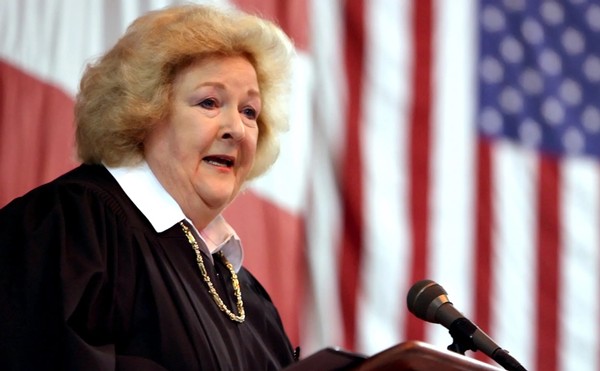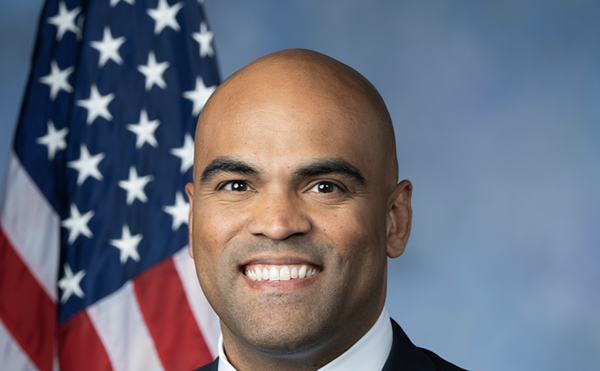Liz Gutierrez, 29, stops when she sees a stranded puppy. Not only does she stop, she picks it up, pays for its shots and sterilization, and tries to find it a home. That’s what she did last spring when she encountered Blue, a tiny black Labrador puppy, ambling near Blue Star Contemporary Art Center, her then place of employment.
“It was by the road, and I knew it was too little to be wandering around alone,” she recalled. “I said hello, and it came right up to me and I scooped him up.” She took the puppy with her when she worked Blue Star’s First Friday festivities, where little Blue had no shortage of admirers, but no serious ones, either. “People gave me their phone numbers, but overall, most people said, ‘We just can’t have a dog right now.’” So Gutierrez took him to her small home and began a routine of calling the local Humane Society every day at 8:30 a.m., the only way to see if the center had space to take in the adorable stray, since the shelter is often at capacity and does not euthanize animals. After two weeks of futile calls, she gave up, meanwhile potty-training, neutering, and taking Blue to the vet. After about three months, Gutierrez serendipitously introduced the once-homeless Lab to a volunteer at an Austin Hospice center. Now Blue spends his days in Austin with another black Lab, and parents that take him to summer in Colorado. “It was like rags to riches,” says Gutierrez.
But one month later, Gutierrez began feeding a stray neighborhood cat in her backyard who surprised her with two kittens. This time, she researched and found the San Antonio Feral Cat Coalition, which offered a cat-colony seminar, a loaner trap, and a voucher for shots and sterilization. After incurring a mere $33 vet bill, Mamacita and her babies are part of Gutierrez’s backyard, with a cozy garage hangout space during inclement weather.
Then Gutierrez met her toughest, and most well-behaved, challenge. While she worked on her grandmother’s Westside house this March, she watched a van with an open door and two kids in the back slowly rounding the block. “I thought that was really curious,” she said. She watched as the van’s female driver sped up a little to pass her, then slowed down again. Suddenly someone shoved a Doberman out of the back door and the van sped away. After failing to catch the vehicle, Liz rescued the dog from a vicious pack of “stupid neighborhood Chihuahuas,” as she calls them. “I automatically started calling the Humane Society for two weeks straight, then I made a list of all the other shelters in the area, which were basically all full. A couple of shelters in Bulverde and Boerne would take her if she was fixed and had her shots.” Liz went to the Animal Defense League for shots at about $30 and Animal Care Services for spaying, but couldn’t bring herself to take Holly the Doberman to a shelter. “You put so much effort into it, you want to make sure she gets a good home,” she says. “I called pretty much every shelter in the book. Some of them sounded more promising than others, but some were totally disorganized.” Luckily, three weeks later a friend of Gutierrez’s adopted Holly.
Sure, she’s described owning an animal ranch-haven à la Kinky Friedman as her dream, but Gutierrez is otherwise an average compassionate San Antonian faced with one of the city’s most vexing problem: stray animals. Despite an ambitious No-Kill 2012 goal, a $7.3-million budget for Animal Care Services, and widespread citizen concern, San Antonio still struggles to come to terms with hundreds of thousands of dogs and cats who wander the streets, lost, abandoned, or feral. The animals’ visibility and the emotional response their suffering elicits only compounds the issue for the city. The many passionate people who form the backbone of the animal-care community often become consumed by anger, stubbornness, and mistrust as they warily eye City efforts to address animal issues, evidenced during the lengthy process that led to the most recent animal-ordinance updates, adopted by Council on June 17. While they haggle over philosophical differences among themselves and with the City over how best to solve the challenge, loving but resource-limited people like Gutierrez still feel there is nowhere reliable to take San Antonio’s oversupply of strays.
Ideas and convictions about how best to care for and manage animals run a wide spectrum. On one side are animal-welfare advocates, comprising those we’ll call pet lovers. On the other are animal-rights activists, perhaps best characterized as animal lovers. Most people probably find themselves somewhere in the middle of these two factions. They may have pets they love, but they don’t breed or rescue them in droves. Pets are (pampered) property to the pet lover, while animals are (wild) friends to the animal lover. Pet lovers can be found at dog shows, in Cat Fancy magazine, and obedience-training schools. Animal lovers protest Lucky the elephant’s enclosure at our local zoo, gather at vegan potluck dinners, and trap, neuter, and release feral cats. At the risk of oversimplification, pet lovers believe in owner rights, while animal lovers believe in animal rights. Both frequently call on Gary Hendel, the latest director of Animal Care Services, to convince him how to best address the City’s stray-animal problem.
Since 2004, when San Antonians first learned that Animal Control euthanized nine out of 10 animals taken in by the pound, a public push to reform the department has resulted in a massive perspective shift. Animal Control was renamed Animal Care and placed directly under the City Manager’s office, making it the epicenter of San Antonio’s new No Kill goal, in which the City promised to stop euthanizing most healthy, adoptable animals by 2012. Six years later, Hendel is the fifth director to oversee operations from the new Animal Care services shelter, where animals brought in at least have a chance of making it out alive, thanks to rescue-group coordination, adoption events, and a friendly campus where residents can walk the kennels to find the Fido or Fluffy of their dreams.
Hendel, a jovial grandpa with rosy cheeks and a gift for gab, says he took on San Antonio’s animal challenge primarily because of its No Kill goal. Despite management work with Maui’s Humane Society and Animal Control in Portland, Oregon’s surrounding county, “I’ve never had that anywhere, and I wanted to be a part of that,” he said in an interview in ACS headquarters’ chilly conference room.
Hendel mixes an unrelenting optimism with candor, which leads him to sign off his emails with a cheering “NO-KILL by 2012 is doable!” but also acknowledge in our interview, “whether we’ll ultimately be successful, I don’t know.” Even that assessment is a retreat from the first time we heard him give a public update on San Antonio’s No Kill 2012 goal, at an Animal Care Services public meeting in early April. “I don’t have a ghost of a chance by 2012,” he told the small crowd. To meet that goal, in less than three years Animal Care Services must release via adoption, rescue, or fostering 70 percent of the animals it deems upon intake as healthy and adoptable. Injured or poorly behaved animals are considered un-adoptable, and hence not counted, though they may be released to individuals willing to rehabilitate them.
Hendel estimates that currently his department has a nearly 30-percent live-release rate, nearly triple the starting live-release rate of 12.5 percent. They started from a point where animal-control officers used gas chambers to euthanize animals en masse. Now ACS euthanizes by injection, sends out an email to rescue groups listing the department’s entire daily animal intake, and holds public adoption events. Yet a team of ACS employees still makes the rounds every day to determine which animals might make it out alive, and which must go to make room for the nonstop parade of paws and tails.
“We need the space, and we know that today I’m going to bring in 50 animals; we’ve got to have 50 kennels. The decision has to be made: Of the animals, whose time is up? What are the worst 50 animals in the kennel?” says Hendel. Meanwhile, ACS can’t stop picking up stray animals; a primary complaint received by most city-council representatives is that ACS already lags in that department as it is, and it’s the key component to ACS’ public-safety mission. The pressure to pick up more animals, without an inexhaustible demand for pets or infinite kennel space, while still toiling under a No Kill goal means much of Hendel’s job comes down not to managing the shelter or his animal-care officers, but to attending meeting after meeting to address what’s yet been an unsolvable problem: reducing the supply of strays. That’s where Hendel often comes into contact with pet lovers and animal lovers.
The two big challenges are responsible pet ownership by citizens of San Antonio; well, I guess that’s really the challenge and within that is spaying and neutering,” says Gavin Nichols, program officer in charge of the San Antonio Area Foundation’s No Kill initiative. “A lot of people in San Antonio don’t get their animal spayed or neutered, and they also let them roam free.” On average one dog can have one to two litters of six to eight puppies a year, adding to San Antonio’s already critically high stray population. Most in the animal-lovers community agree that sterilizing as many dogs and cats as possible is crucial to reducing unwanted animals. The City’s Animal Care Strategic plan, last updated in 2008, increased the number of high-volume, low-cost spay and neuter clinics. The City also supports the Trap Neuter Release initiative for feral cats, which mandates that they all be sterilized, and requires any dog or cat adopted out of the Animal Care facility to be spayed or neutered within 30 days.
But animal lovers like John Bachman, a board member of Voice for Animals, don’t think the City and Animal Care Services do enough to encourage spay and neuter, either through policy or funding, to achieve the No Kill goal and end the suffering endured by unwanted pets. Bachman is such a frequent face at City Council meetings when Animal Care Services items are on the agenda that the City Manager knows him by name. A self-described hermit and retired Air Force engineer, Bachman, 68, lives on Medina Lake with 16 cats he calls his sweeties and boxes full of statistics on stray-animal populations. His shabby mien and dry sense of humor call to mind a world-weary Peter Falk in the old Colombo TV series. But where everyone accepted Columbo’s conclusions drawn from the thinnest of evidence, Bachman despairs that his piles of papers and blustery speeches to Council have done little to convince City officials of the only way he sees to spare generations of animals an untimely end on the streets or in ACS’s back room.
“We want zero population growth,” he said during an interview at a Northside bar. Bachman’s retired-bachelor lifestyle and nuclear-engineering background manifest in his animal activism as charts, graphs, and projection slopes. By his estimates, at least 150,000 new animals need to be spayed or neutered each year over the next three to four years to reach a point where reproduction numbers match the community’s capacity to house them, at which point the stray-animal population’s vertical climb begins to flatten. Then the No Kill goal would become all the easier to attain, he says, since the lack of “free” stray animals, such as those that wandered into Gutierrez’s life, would cause more would-be pet owners to turn to adoptions.
The way to get there, in Bachman’s impatient eyes, is a combination of laws and money. To this effect, he has sent hundreds of emails to Hendel since first meeting with him in late July. For nearly 20 years, Bachman has supported a mandatory spay-and-neuter policy and increased funding to make it happen. And he’s not alone. A recent survey of the focus group that reviewed the City’s animal ordinance revealed the majority favored mandatory spay-and-neuter for all city pets, with the exception of service dogs, show dogs, and police and military dogs. In an October 30 email from Hendel to Bachman, Hendel agreed that “spay and neuter is the answer but what is needed is not token dollars. We need a concerted effort to reduce the numbers born, and this needs to be done over 5-10 years and we’ve talked about $4 mil a year. Obviously the adoptions and rescuers are a visible cog in the success wheel but if you adopt 1,000 more dogs and 2,000 are born have you really moved forward? Spay/Neuter!” Bachman replied: “I have been saying that for years. You and I agree but is anyone else listening?”
A mandatory spay-and-neuter policy seems to be unpopular with the average San Antonian unfamiliar with animal issues, though not necessarily for any substantive reason. A 2007 study commissioned by ACS and conducted by the University of Texas at San Antonio’s Culture and Policy Institute found that although most respondents did not oppose spaying or neutering their pet, they did not see it as important. Their reaction to the City enacting a mandatory spay-and-neuter law was “mixed at best,” according to the study: “The feelings of many participants were along the lines of ‘don’t tell me what to do.’” Though it was included in early public discussions of the recently revised Chapter 5 city-code animal ordinance, by the fourth of six public meetings on the ordinance, Hendel told the audience not to worry, the suggestion was already off the table.
That legislative blow didn’t seem to upset Bachman as much as the City’s decision earlier this year to open 135-140 more kennels at Brooks City Base, a move he calls a return to catch and kill. “The adoption and rescue efforts are maxed out,” he said over a pitcher of beer. In his view, opening more kennel space, without an equal commitment to increase adoptions or reduce population by spay and neuter, can only lead to an increased euthanasia rate. It is perhaps not the actual euthanasia uptick that disturbs Bachman so much — he wrote to Hendel after learning of the Brooks City Base deal, “I think I told you once that I would go along (hypothetically) with the killing of all the strays if that would end `catch and kill`, meaning that enough spay and neuter and adoptions would ensure no more killing” — as it is the misdirection of funds. Though the Brooks City Base deal appealed to the City because it included several already constructed kennels, Bachman argues that the amount of money spent on lease and upkeep could have funded tens of thousands of low-cost spay and neuter procedures through grants to facilities that already offer them or through voucher programs to further reduce surgery price. To Bachman the public-safety concerns that keep City Council pushing for more ACS stray pick-ups have nothing on the continued plight of strays. “Any action that results in the death of 10,000-20,000 animals is not something to celebrate,” he said as he polished off his pint.
Hendel agrees with Bachman in principle, but differs in the details. “His solution is actually the right solution, but it’s not acceptable to the general public,” Hendel said. “The only way that really works, you have to have $2 million every year for six years.” As for a mandatory spay-and-neuter policy, the best Animal Care Services has managed is encourage sterilization with lower registration fees for fixed dogs. Even that solution is highly contentious among the group on the opposite end of the spectrum from the animal lovers, the pet lovers.
At the River City Cluster of Dog shows in mid-June, extremely rare Harlequin Great Danes, a cross between Marmaduke and a Dalmatian, traversed the concrete floor of the Henry B. Gonzalez Convention center, joined by tiny Chinese Cresteds wearing rubber-ducky booties to protect their manicured paws. Moxxee, a 2-by-2-foot chunk of fluffy golden fur with a Chow’s face, relaxed in her kennel, waiting to be shown by her owner and attended to by the owner’s granddaughter, a teenager sporting a smock embroidered with a logo reading “Kuddlebearz Chows,” a new-wave hairstyle, and thick black eyeliner. Moxxee’s owner, Jacque Kennedy, kindly led this reporter on a tour, navigating between grooming spaces where Afghan Hounds wore leopard-print snoods over their flowing ears, indoor animal potties, show rings, and electrical sockets covered with heavy mats to prevent a puppy-pee-induced electrical fire.
Kennedy and Moxxee aren’t just here for the show. Kennedy also helps man the info booth of the Responsible Pet Owners Alliance, the organization where she spends most of her daytime hours. The local group is led by Mary Beth Duerler, a friendly woman with a silver-and-white coif and pink lipstick. When Duerler shows up to the booth, she’s laughing and walking her “PETA pet” — a gag invisible dog leash that symbolizes her belief that People for the Ethical Treatment of Animals wants to “legislate pet ownership out of existence.” In fact, among PETA’s many animal-rights positions, it encourages adopted pets, but refers to them as “companion animals,” and their human keepers not as owners but as “guardians,” terms that incense pet lovers. Duerler and her group oppose not only PETA, but any group that encourages restrictive legislation on those they proudly call “pet owners.” Flyers distributed at the RPOA booth encourage people to contact the media and City officials and tell them to “stop listening to the ‘animal rights vegans,’ who want to eliminate all animal use, breeding and ownership (including pet ownership) of animals and have limited knowledge about animals.”
Duerler helped found the group in 1991, when she met like-minded folks at City Hall who were protesting proposed mandatory spay and neuter and breeder permits. “We’ve been doing this for 20 years,” she said, then laughed, “of course, we didn’t know we’d be here 20 years.” She doesn’t breed dogs or show them, though she prefers pure-bred Staffordshire Bull Terriers. A widow, she has only one dog these days, and doesn’t want another puppy. “Where will I be in 10 years?” she asks by way of explanation. She became involved with the American Kennel Club, the strongest national opponent of mandatory spay and neuter policies, through her love of obedience training. It is perhaps this faith in persistent training that sustains her belief that if pet owners only learned the benefits of sterilization, leashes, and basic behavioral strategies, much of the stray animal problem would be solved. No legislation needed. And certainly no fines.
“If we could get people to confine their pets, that would solve 85 percent of the problem,” said Duerler in the small office she shares with Kennedy. RPOA disavows the notion of pet overpopulation, believing that the root problem is that owners either choose to relinquish badly behaving animals, and frequently do so by dumping them in the streets rather than a shelter, or animals truly “stray” away from their homes when allowed to escape or roam freely, especially those animals still intact and lured away by breeding opportunities. Duerler and her group promote “pet retention” with one of the largest education resources in the community, which is centered on a hotline for animal issues, courses for pet owners who are considering giving up their pets, and outreach to neighborhood associations to help them solve their area’s specific pet problems. The group supports educating owners to keep animals on a leash, indoors or supervised at all times, yet vehemently opposes anti-tethering legislation, which makes it illegal to keep pets tied up, unsupervised, in one’s yard. They publicize low-cost spay-and-neuter solutions, yet despise even the mention of legislative mandates, increased fees for intact animals, or fines.
Part of Duerler and her group’s vigor comes from a near-libertarian approach to pet ownership and part comes from a belief that they stand up for the low-income pet owner, whom they say is unfairly targeted for non-compliance with confinement and spay-and-neuter requirements that may be more easily accomplished by wealthier people. On this point, Duerler often invokes the name of Nathan Winograd, father of the No Kill movement, who dislikes spay-and-neuter fees and requirements for the same reasons. Duerler also promotes a conspiracy theory that holds that RPOA’s arch-enemy animal-rights groups have already corralled City officials into their plot to destroy pet ownership once and for all. “If every animal is spayed or neutered,” Duerler asked me, “where are the future pets going to come from?”
Duerler, who spends most evenings in her “lounger” watching television with her dog, works just as hard as Bachman to convince Animal Care Services and City Council of her point of view, frequently tapping a national network of breeders and pet enthusiasts through the American Kennel Club. She also co-founded the RPOA Texas Outreach, a lobbying group. Their mission statement’s top two objectives are to promote and preserve the human-animal bond and our historic working relationship with animals, and expose the extreme agenda of the Animal Rights Movement. The group’s frequent description of San Antonio as “the most anti-pet city in America,” so riles up her national network that Hendel has received hundreds of calls and emails from across the country opposing various Animal Care policies, often ones that have already been rescinded or removed from consideration. He has also received indirect death threats that suggest he, too, should be euthanized. “I’m not your enemy,” Hendel told Duerler via email in April, “I hold most of the same ideas you do but if you THINK I disagree on an issue, you label me as an enemy who is aligned with the animal rights folks.” Duerler replied, “You misunderstand, it isn’t you who are the enemy, it is RPOA/us who must be portrayed as the enemy because we keep saying all this animal rights stuff won’t work and we offer truly proactive solutions.”
The “animal rights stuff” Duerler refers to includes, among other things, issuing permits and enforcing codes for pet-owning humans, both set by the new Chapter 5 animal-care ordinance provisions, an update to a city code largely reworked in 2007. Both Bachman and Duerler were included in the focus-group meetings this spring along with 10 others from the City, the Area Foundation, the ACS advisory board, neighborhood associations, and other local animal-care groups representing the spectrum on which Bachman and Duerler sit at either end. The ordinance covers everything from dangerous dogs to chicken coops and the accompanying fee schedule prices out costs for licensing animals, breeding litters, and impounding animals. Many fees and rules address directly or indirectly spaying and neutering, to the particular interest of Bachman and Duerler, though they also have plenty to say about most other aspects of the law.
“I do not support the laws … just because I like laws,” Bachman wrote to us in an email. “I do not, except those that protect animals. If there were enough spay-and-neuter capability, and if people used it and enough animals were fixed, then the laws would not be needed. I feel that even if we get the needed capacity some incentive in the form of laws or fees will be needed.”
Yet Duerler and her supporters point out that due to an overwhelming workload for at most 14 animal-control officers per shift, many of those legal “incentives” go unenforced. For instance, from October 2009 to October 2010, ACS collected $975 in charges to people found to have a litter of puppies without the corresponding litter permit. And the City has issued only 359 of those permits, granted to owners of pets that have one litter per year, since they began granting them in March 2008. Last year, they granted just 774 intact permits to pet owners who decided not to spay or neuter their animal. Why would ACS create more regulations when they can’t enforce the ones they already have, Duerler has asked several times.
The effort to revise Chapter 5, which began in August 2009 and stretched over the next 10 months, has been particularly contentious for Hendel and the pet lovers and animal lovers he’s been trying to placate since arriving last summer. Initially, he seemed to agree with both Bachman and Duerler. “We thought when Gary came here, all our problems would be solved,” sighed Duerler in the RPOA offices. In an email to Hendel dated July 23, Bachman wrote, “I am encouraged that you really want to get things done and I hope I can help you with information and some insight into the people and organizations involved.” But a year of increasingly frustrated and irate interactions followed. After the Brooks City Base vote, Bachman angrily confronted Hendel in the middle of the Council Chambers. Meanwhile, Hendel has referred to Duerler as dishonest and inflammatory. Duerler believes Hendel is sympathetic to animal-rights activists; Bachman sees Hendel as refusing to stand up to the City’s “knee-jerk” demands to pick up more strays without first providing more space to house them. They both accuse Hendel of playing to different audiences at different times.
The Current requested Hendel’s email correspondence between Duerler, Bachman, and a neutral third party who represents the Alamo Area Partners for Animal Welfare, whose job it is to bring the Duerlers and Bachmans to the table. What we found was some skillful verbiage, but statements that actually reflected the same message to both parties. Hendel does tell Duerler he believes spay-and-neuter is a major part of the solution to the stray-animal problem, but he also tells Bachman he must support public-safety initiatives such as picking up strays. “When you get these highly divergent people in the same room, they say the same thing,” said Hendel in his interview with the Current.
Bachman and Duerler do agree that Hendel should take little blame for what they regard as the City’s misguided attempts to simultaneously push forward on both the ambitious No Kill goal and satisfy the public’s demand to round up strays.
They also agree that the Chapter 5 ordinance was rushed through Council. After holding six public meetings in March and April, Animal Care Services called for a focus group. The group met four times, with only six of the original 17 members participating in the last meeting. Hot topics included how to encourage spaying and neutering and discourage tethering. With mandatory spay-and-neuter off the table early on, the conversation turned to permits for intact animals and policies to sterilize impounded animals. Happily for Duerler, the intact-animal permit got axed, but those who register their pets now have to pay $45 more for unsterilized animals. This compromise was derided even by members of the ACS advisory board, with Vice President Randy Murdock saying of the internet-registration process, “What’s the average idiot going to do? Say ‘yeah, he’s neutered.’”
An anti-tethering law, abhorred by Duerler, also did not end up in the final document, though there is now a provision that forbids tethering female dogs in heat to better protect them from impregnation. Overall, Duerler says she’s delighted. “We killed everything we set out to,” she said after the ordinance passed.
Several members of the focus group asked for one more meeting before the revisions went to Council. The document, on its sixth rendition by the time Council read it, confused focus-group members on several points, including who would be required to obtain a seller’s permit (valid for those who sell puppies ages 2-to-4-months old, but not required for entities already purchasing the less expensive pet store or breeder permits), why cruelty to wild animals in public places is specifically addressed when cruelty to domestic animals in public places is not, and why cats have a flat registration fee whether sterilized or unsterilized while owners of unfixed dogs must pay a much higher registration fee.
One member of the focus group wrote Hendel an email on June 1 stating, “I concur with John in his assessment that the language of the existing Chapter 5 Ordinance is a confusing patchwork and subject to interpretation and misunderstanding. And in some cases, inadvertently made more so by recent revisions … I would like to suggest that a representative group from the focus group and the ACSAB form a Task Force along with ACS/City staff to go over the entire document line by line, paragraph by paragraph, soliciting input as necessary for clarification.” Yet City Council passed the document unanimously on the consent agenda. Hendel did not appear worried about inconsistencies, telling the Current that Assistant City Manager T.C. Broadnax asked for another review of the law in the next two-to-three years. “We’re trying to meet the Mary Beths and the John Bachmans and still have something that makes sense to T.C.,” Hendel said.
Although they represent two opposing sides to the City, Bachman and Duerler each belong to Alamo Area Partners for Animal Welfare, a venue where, Duerler says, “we’re working together for animals and we put everything else aside.” In an effort to satisfy a primary goal of both pet- and animal-lovers in San Antonio, AAPAW will soon roll out a publicity campaign with San Antonio Spurs basketball star Manu Ginobli called “together we CAN!” aimed at educating San Antonians about the benefits of spay-and-neuter and adoption. AAPAW is also partnering with another publicity campaign soon to be launched by the San Antonio Area Foundation’s No Kill initiative called “Talk About It.” The bilingual effort is slated to roll out in July and also addresses what San Antonians can do to achieve No Kill. On the Talk About It website (talkaboutitsa.org) a box labeled “Why?” answers: “Each day, an average of 60 unwanted or stray cats and dogs enter the city’s Animal Care Services shelter. Sadly, only 16 of these homeless pets leave the shelter alive through adoptions, transfers to rescue groups, and reunions with their owners.”
The thousands of unwanted strays who don’t make it to ACS’s shelter are still roaming San Antonio’s streets and vacant lots for the foreseeable future. Occasionally one is lucky enough to find a Liz Gutierrez who may take them in. But even Gutierrez has her limits. We happened to run into her last weekend at a Southtown ice house. Just after saying hello, Gutierrez spotted a young man outside the establishment carrying a cardboard box with “free kittens” scrawled on top. “Oh, no,” Gutierrez says. “Keep me away from them. I already have enough.”


















